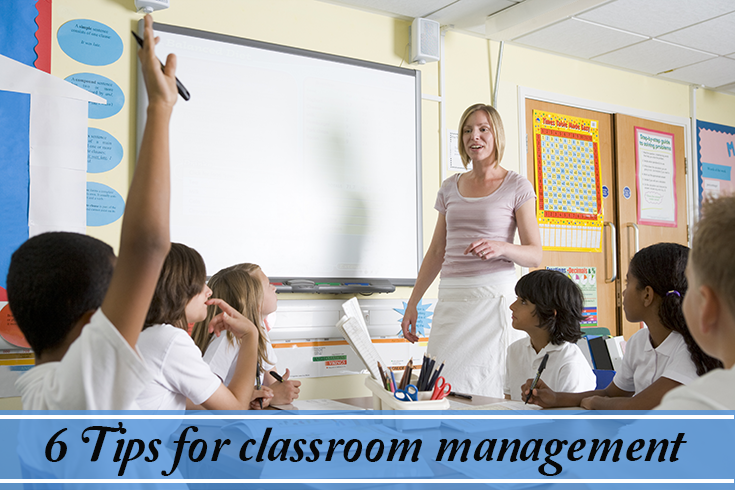6 Tips For Classroom Management
Posted by Network Support · Leave a Comment
Teach it. Model it. Practice and encourage it until it becomes part of the fabric of your classroom…
Most of the outcomes desired in classrooms depend to a great extent on the teacher’s ability to be a good classroom manager. A class where students are disorderly and no rules guide behavior, chaos is bound to happen. In contrast, well-managed classrooms facilitate an environment where learning can flourish. Clearly, classroom management by individual teachers can have a major impact on student behavior and academic achievement.
So what do good classroom managers do? The answer – They create an environment which promotes learning, motivation, and collective function. Thus, a great deal of what we might call classroom management style comes from attitudes and pedagogical choices. Here are a few classroom management techniques which will help teachers assist their students in positive behaviors.
1. Create Clarity
Clarity within the classroom has been found to correlate positively with student achievement, level of engagement, and student satisfaction. For this, students need to clearly know, what is expected out of them. Without clarity, they are forced to guess and end up creating a vacuum in expectations, which students try to fill with their own ideas of conduct. Additionally, the teacher needs to infuse a sense of positive intention and movement to the class. When the class experiences the deliberate movement toward a goal they are much less likely to be bored, distracted, or likely generate a negative feeling of lack of purpose.
2. Be Consistent
Along with clarity, if the element of consistency exists in a classroom, things will run relatively smoothly. The consistency of one’s actions promotes or detracts the notion of whether a person is trustworthy. Part of being trusted by students is being reliable. When our decision-making process is perceived as too subjective or random, students lose trust. The loss of trust usually translates into a loss of commitment on the part of the student.
Also, when teachers are working with a student or a class to help shape behavior patterns, reinforcing of more functional behavior is necessary. In many cases, even a small amount of contradictory reinforcement can undermine efforts. Consistency helps clarify the cause and effect positive thinking. Inconsistency confuses it.
3. Incorporate Pedagogy
When a teacher provides students with a curriculum defined by monotonous tasks and exclusively teacher-directed learning, they should expect problems. Students subjected to these types of passive learning often use disruptive behavior to achieve a sense of control, engagement, satisfaction, and fun. On the other hand, students who are engaged, challenged, and see a real-world value to their work will be much more interested in learning than creating problems.
When students feel successful, they associate that success with the source – the teacher – and when they are bored and unsuccessful, so they again associate that experience with the teacher as well.
4. Satisfy Basic Needs
If the students’ basic needs for power, competence, belonging, freedom, and fun are not provided for by their teacher, they will find ways to meet those needs by other means. Often those other means include display of unwanted and/or problematic behavior.
When teachers create engaging learning activities that create a sense of “psychological movement” in the class, a good portion of the reasons for misbehavior and lack of interest are removed and replaced with reasons for students to invest and enjoy their time in class.
5. Facilitate Bonding
In general, a teacher acts as the primary force in the room helping students become responsible to one another while developing the group’s capacity to function. And while classroom rules answer the question: “What am I supposed to do in here?” bonding answers the question: “What, if I did it, would help the class function more effectively, and best ensure my success?”
Few students feel a sense of ownership over rules. However, bonds by their very nature are owned by those who share them, and therefore are much more likely to lead to responsible behavior.
6. Teach Procedures
If students do not know how to behave, listen, smoothly transition from one thing to another, interact respectfully, work cooperatively in a group, resolve conflict, process failures, line up, or continue to perform when the teacher leaves the room, etc., it is the teacher’s responsibility to effectively tutor them in these important aspects. The teacher should think about teaching classroom procedures in the same way as thinking about teaching any other content.
As teachers become more effective at staying in the moment, keeping their attention on what they can do to improve the situation, and take on an attitude of appreciation for their students, not only will they be able to deal with problems more effectively, but also end up having fewer to deal with in the first place.
Like this article for teachers?
Browse the Professional Learning Board COURSE CATALOG to find related online courses for teachers in your state. Professional Learning Board is a leading provider of online professional development classes that teachers use to renew a teaching license or renew a teaching certificate.





